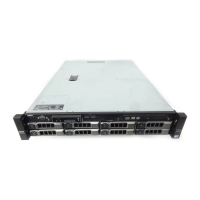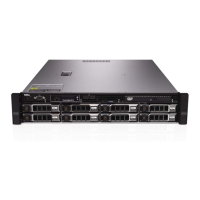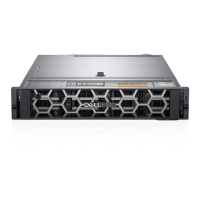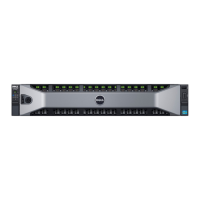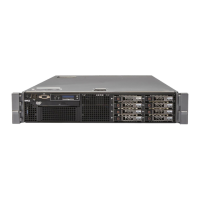Do you have a question about the Dell PowerEdge R520 and is the answer not in the manual?
Details about front and back panel indicators, buttons, and connectors.
Explains hard drive, NIC, and power indicator patterns and access to setup menus.
Guide to entering System Setup, navigation keys, boot modes, and basic options.
Covers BIOS, memory, processor, storage, boot, devices, serial, profile, security, and misc settings.
Explains system/setup passwords, UEFI boot manager, and iDRAC settings.
Procedures for installing front bezel, opening/closing system, cooling shroud, and fans.
Guides for installing memory modules, hard drives, optical drives, USB keys, expansion cards, and SD cards.
Instructions for installing or replacing processors and AC/DC power supplies.
Addresses system startup failures, external connections, video, USB, serial, and NIC issues.
Guides for troubleshooting wet systems, battery, power supplies, cooling, memory, drives, and other components.
Explains Dell Online and Embedded System Diagnostics, including running tests and interpreting results.
Details system board jumper settings, connector locations, and disabling forgotten passwords.
Explains LCD messages, viewing, removing them, and general system error messages.
Describes warning, diagnostic, and alert messages and how to respond to them.
Information on how to contact Dell for technical support and service.
Details about front and back panel indicators, buttons, and connectors.
Explains hard drive, NIC, and power indicator patterns and access to setup menus.
Guide to entering System Setup, navigation keys, boot modes, and basic options.
Covers BIOS, memory, processor, storage, boot, devices, serial, profile, security, and misc settings.
Explains system/setup passwords, UEFI boot manager, and iDRAC settings.
Procedures for installing front bezel, opening/closing system, cooling shroud, and fans.
Guides for installing memory modules, hard drives, optical drives, USB keys, expansion cards, and SD cards.
Instructions for installing or replacing processors and AC/DC power supplies.
Addresses system startup failures, external connections, video, USB, serial, and NIC issues.
Guides for troubleshooting wet systems, battery, power supplies, cooling, memory, drives, and other components.
Explains Dell Online and Embedded System Diagnostics, including running tests and interpreting results.
Details system board jumper settings, connector locations, and disabling forgotten passwords.
Explains LCD messages, viewing, removing them, and general system error messages.
Describes warning, diagnostic, and alert messages and how to respond to them.
Information on how to contact Dell for technical support and service.
| Bus type | QPI |
|---|---|
| Stepping | M1 |
| FSB Parity | No |
| Scalability | 2S |
| Processor code | SR0LR |
| Processor cache | 10 MB |
| Processor cores | 4 |
| Processor model | E5-2407 |
| System bus rate | 6.4 GT/s |
| Processor series | Intel Xeon E5-2400 |
| Processor socket | LGA 1356 (Socket B2) |
| Processor codename | Sandy Bridge EN |
| Motherboard chipset | Intel C600 |
| Number of QPI links | 1 |
| Processor frequency | 2.2 GHz |
| Processor cache type | Smart Cache |
| Processor lithography | 32 nm |
| Processor manufacturer | Intel |
| Processor package size | 45 x 42.5 mm |
| Processor front side bus | - MHz |
| Processor operating modes | 64-bit |
| ECC supported by processor | Yes |
| Supported instruction sets | AVX |
| Thermal Design Power (TDP) | 80 W |
| Number of processors installed | 2 |
| Maximum number of PCI Express lanes | 24 |
| Memory types supported by processor | DDR3-SDRAM |
| Memory channels supported by processor | Triple |
| Memory clock speeds supported by processor | 800, 1066 MHz |
| Memory bandwidth supported by processor (max) | 25 GB/s |
| Maximum internal memory supported by processor | 375 GB |
| HDD size | 2.5 \ |
| HDD speed | 15000 RPM |
| HDD interface | Serial Attached SCSI (SAS) |
| Optical drive type | DVD-RW |
| Internal drive bays | 8 |
| Total storage capacity | 146 GB |
| Maximum storage capacity | 24 TB |
| Memory slots | 12x DIMM |
| Internal memory | 8 GB |
| Memory clock speed | 1333 MHz |
| Maximum internal memory | 196608 MB |
| PS/2 ports quantity | - |
| USB 2.0 ports quantity | USB 2.0 ports have a data transmission speed of 480 Mbps, and are backwards compatible with USB 1.1 ports. You can connect all kinds of peripheral devices to them. |
| PCI Express slots version | 3.0 |
| Power supply | 750 W |
| Cables included | AC |
| Compatible operating systems | Windows Server 2008 R2 SP1 Windows Small Business Server 2011 SUSE Linux Enterprise Server Red Hat Enterprise Linux |
| Chassis type | Rack (2U) |
| Processor ARK ID | 64614 |
| Intel Identity Protection Technology version | 0.00 |
| Depth | - mm |
|---|
